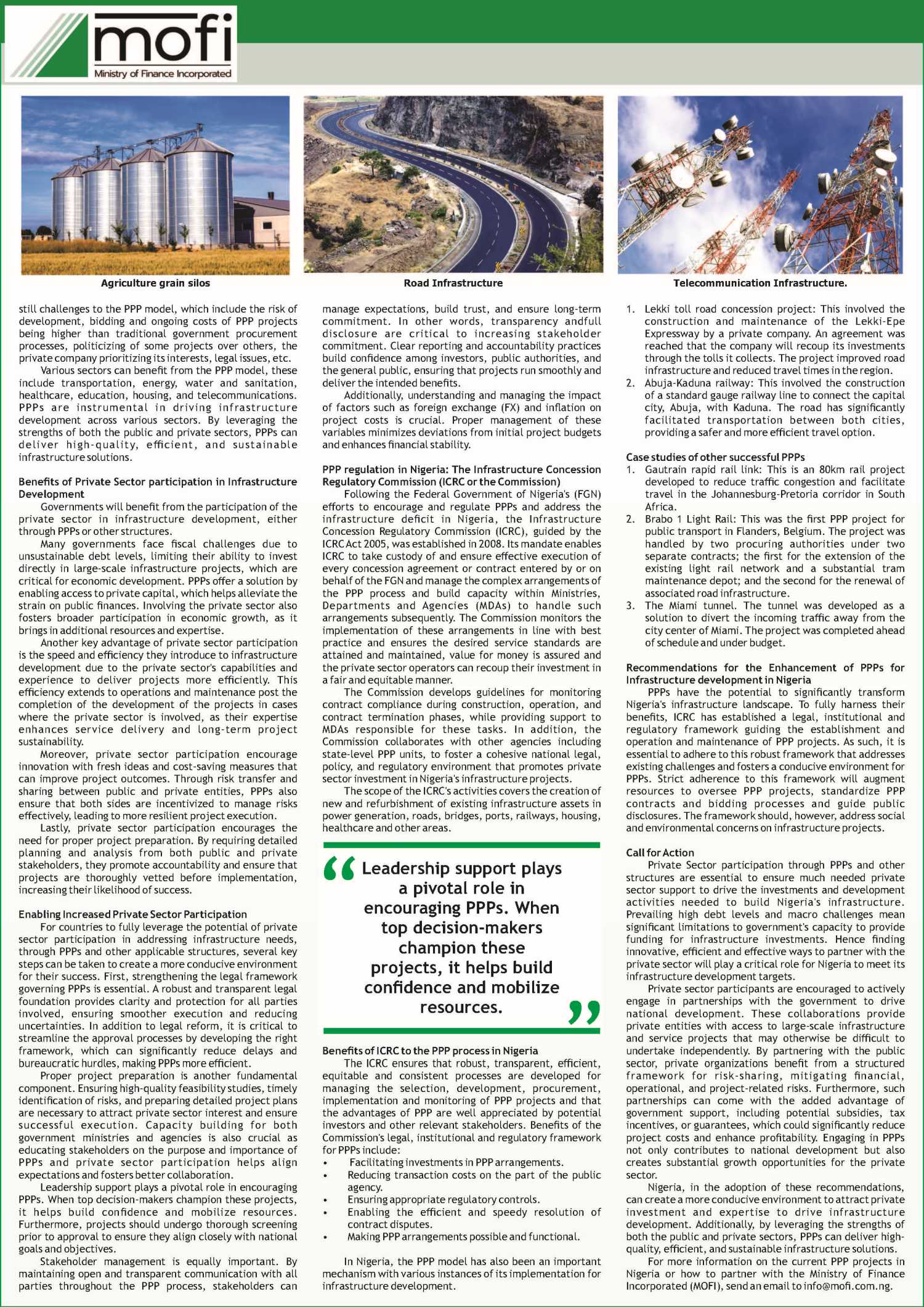As Nigeria’s population continues to grow, increasing by approximately 88% in the last two (2) decades, the inadequacies of its infrastructure, one of the
major hindrances to economic growth and development, has become even more evident. Despite being one of Africa’s largest economies, the country struggles with inadequate transportation networks, unreliable power supply, and insufficient water and sanitation facilities. These deficiencies limit business operations, restrict access to essential services, and reduce the quality of life for millions of Nigerians, and overall, negatively impacts economic growth. Addressing this challenge is therefore crucial to the way of life of the average Nigerian and mitigating efforts will require addressing the infrastructure gap in the country.
According to the World Bank, “investing in sustainable infrastructure helps connect people with opportunities, promotes economic growth, and improves livelihoods”. Infrastructure gap is the disparity between the existing infrastructure and the infrastructure needed to support economic growth and societal well-being. Globally, this gap is prevalent in various sectors, including transportation, energy, water, and telecommunications. The World Economic Forum posits that the world will be faced with an infrastructure gap of $15 trillion by 2040. In addition, according to the World Bank, infrastructure remains alarmingly insufficient, across a wide range of the developing world. About a billion people live over two (2) kilometers from a year-round accessible road, 675 million lack access to electricity at home, and close to four (4) billion people still live in areas without Internet coverage. In Nigeria, the story is not different as the country has limited access to electricity and insufficient road networks, which prevents domestic economic integration that would facilitate the wide-scale utilization of the country’s large market size.


As at 2018, 60 million Nigerians had no access to basic drinking water and 80 million people lived without improved sanitation facilities and by 2021, the value of Nigeria’s infrastructure was c. 30% of Gross Domestic Product (GDP), paling in comparison to 40% – 70% of comparable developing economies (South Africa – 87%, Kenya – 50%, Egypt – 60%), and 70% benchmark set by the World Bank. These datapoints and context highlight the need for more concerted efforts to close the infrastructure gap. Addressing the infrastructure gap is crucial for several reasons, including promoting economic growth by improving connectivity, reducing transportation costs, and enhancing productivity. It also ensures access to essential services such as clean water, reliable energy, and efficient transportation, thereby improving the quality of life for citizens. Furthermore, it can help mitigate the impacts of climate change by promoting sustainable and resilient infrastructure development.
“According to the World Bank, “investing in sustainable infrastructure helps connect people with opportunities, promotes economic growth, and improves livelihoods”.
The Role of Public-Private Partnerships (PPP) and the PPP Model in Closing the Infrastructure Gap
The role of the private sector in economic development cannot be overstated. Public-Private Partnerships (PPPs) are one of such areas where the private sector can facilitate economic development. PPPs are collaborative agreements between government entities and the private sector to build, finance, and operate infrastructure projects. The PPP model leverages the strengths of both the public and private sectors, which includes the public sector’s policies and regulatory framework and the private sector’s capital, efficiency, and innovation. The PPP model can take three major forms and other variations of these major forms. These include the Design-Build-Finance-Operate (DBFO), Build- Operate- Transfer ( BOT), and Concession agreements.
Under the BOT approach, the government grants a concession to a private company to finance, build, and operate a project. There is an agreement on the period of operation by the private company to recoup investments. After this period, control of the project is transferred to the Government/Public entity. The DBFO method combines the financing, design, construction, and operation of infrastructure projects into a single contract with a private entity. This allows for streamlined project management and typically leads to cost savings and improved efficiency, making it an attractive option for PPPs. For Concession based PPPs, the private sector concessionaire is responsible for the end-to-end provision of the specified infrastructure services. This includes the capital investment, operation, maintenance, management, construction, and rehabilitation of the project. The private sector is however responsible for providing the infrastructure assets and retains ownership of the assets even during the concession period. Other types of PPPs include Service Contract PPPs, where the public sector employs the services of a private company to carry out some specified tasks or services for an agreed period, usually about 1–3 years; Management Contract PPPs where the private entity provides managerial service for a public sector institution; and Lease Contact PPPs, where the private sector is responsible for the infrastructure service in its totality and undertakes responsibilities relating to quality and service standards, excluding new and replacement investments, which usually remain the responsibility of the public sector.
PPPs have numerous benefits, including access to private financing, expertise and efficiency, risk transfer, improved service delivery, accelerated economic growth, sustainability, and inclusivity, etc. Nonetheless, there are still challenges to the PPP model, which include the risk of development, bidding and ongoing costs of PPP projects being higher than traditional government procurement processes, politicizing of some projects over others, the private company prioritizing its interests, legal issues, etc.
Various sectors can benefit from the PPP model, these include transportation, energy, water and sanitation, healthcare, education, housing, and telecommunications. PPPs are instrumental in driving infrastructure development across various sectors. By leveraging the strengths of both the public and private sectors, PPPs can deliver high- quality, efficient, and sustainable infrastructure solutions.
Agriculture grain silos | Road Infrastructure | Telecommunication Infrastructure.
Benefits of Private Sector participation in Infrastructure Development
Governments will benefit from the participation of the private sector in infrastructure development, either through PPPs or other structures.
Many governments face fiscal challenges due to unsustainable debt levels, limiting their ability to invest directly in large-scale infrastructure projects, which are critical for economic development. PPPs offer a solution by enabling access to private capital, which helps alleviate the strain on public finances. Involving the private sector also fosters broader participation in economic growth, as it brings in additional resources and expertise.
Another key advantage of private sector participation is the speed and efficiency they introduce to infrastructure development due to the private sector’s capabilities and experience to deliver projects more efficiently. This efficiency extends to operations and maintenance post the completion of the development of the projects in cases where the private sector is involved, as their expertise enhances service delivery and long-term project sustainability.
Moreover, private sector participation encourage innovation with fresh ideas and cost-saving measures that can improve project outcomes. Through risk transfer and sharing between public and private entities, PPPs also ensure that both sides are incentivized to manage risks effectively, leading to more resilient project execution.
Lastly, private sector participation encourages the need for proper project preparation. By requiring detailed planning and analysis from both public and private stakeholders, they promote accountability and ensure that projects are thoroughly vetted before implementation, increasing their likelihood of success.
Enabling Increased Private Sector Participation
For countries to fully leverage the potential of private sector participation in addressing infrastructure needs, through PPPs and other applicable structures, several key steps can be taken to create a more conducive environment for their success. First, strengthening the legal framework governing PPPs is essential. A robust and transparent legal foundation provides clarity and protection for all parties involved, ensuring smoother execution and reducing uncertainties. In addition to legal reform, it is critical to streamline the approval processes by developing the right framework, which can significantly reduce delays and bureaucratic hurdles, making PPPs more efficient.
Proper project preparation is another fundamental component. Ensuring high-quality feasibility studies, timely identification of risks, and preparing detailed project plans are necessary to attract private sector interest and ensure successful execution. Capacity building for both government ministries and agencies is also crucial as educating stakeholders on the purpose and importance of PPPs and private sector participation helps align expectations and fosters better collaboration.
Leadership support plays a pivotal role in encouraging PPPs. When top decision-makers champion these projects, it helps build confidence and mobilize resources. Furthermore, projects should undergo thorough screening prior to approval to ensure they align closely with national goals and objectives.
Stakeholder management is equally important. By maintaining open and transparent communication with all parties throughout the PPP process, stakeholders can manage expectations, build trust, and ensure long-term commitment. In other words, transparency andfull disclosure are critical to increasing stakeholder commitment. Clear reporting and accountability practices build confidence among investors, public authorities, and the general public, ensuring that projects run smoothly and deliver the intended benefits.
Additionally, understanding and managing the impact of factors such as foreign exchange (FX) and inflation on project costs is crucial. Proper management of these variables minimizes deviations from initial project budgets and enhances financial stability.
PPP regulation in Nigeria: The Infrastructure Concession Regulatory Commission (ICRC or the Commission)
Following the Federal Government of Nigeria’s (FGN) efforts to encourage and regulate PPPs and address the infrastructure deficit in Nigeria, the Infrastructure Concession Regulatory Commission (ICRC), guided by the ICRC Act 2005, was established in 2008. Its mandate enables ICRC to take custody of and ensure effective execution of every concession agreement or contract entered by or on behalf of the FGN and manage the complex arrangements of the PPP process and build capacity within Ministries, Departments and Agencies (MDAs) to handle such arrangements subsequently. The Commission monitors the implementation of these arrangements in line with best practice and ensures the desired service standards are attained and maintained, value for money is assured and the private sector operators can recoup their investment in a fair and equitable manner.
The Commission develops guidelines for monitoring contract compliance during construction, operation, and contract termination phases, while providing support to MDAs responsible for these tasks. In addition, the Commission collaborates with other agencies including state-level PPP units, to foster a cohesive national legal, policy, and regulatory environment that promotes private sector investment in Nigeria’s infrastructure projects.
“The scope of the ICRC’s activities covers the creation of new and refurbishment of existing infrastructure assets in power generation, roads, bridges, ports, railways, housing, healthcare and other areas.”
Leadership support plays a pivotal role in encouraging PPPs. When top decision-makers champion these projects, it helps build confidence and mobilize resources.
Benefits of ICRC to the PPP process in Nigeria
The ICRC ensures that robust, transparent, efficient, equitable and consistent processes are developed for managing the selection, development, procurement, implementation and monitoring of PPP projects and that the advantages of PPP are well appreciated by potential investors and other relevant stakeholders. Benefits of the Commission’s legal, institutional and regulatory framework for PPPs include:
- Facilitating investments in PPP arrangements.
- Reducing transaction costs on the part of the public agency.
- Ensuring appropriate regulatory controls.
- Enabling the efficient and speedy resolution of contract disputes.
- Making PPP arrangements possible and functional.
In Nigeria, the PPP model has also been an important mechanism with various instances of its implementation for infrastructure development.
- Lekki toll road concession project: This involved the construction and maintenance of the Lekki-Epe Expressway by a private company. An agreement was reached that the company will recoup its investments through the tolls it collects. The project improved road infrastructure and reduced travel times in the region.
- Abuja-Kaduna railway: This involved the construction of a standard gauge railway line to connect the capital city, Abuja, with Kaduna. The road has significantly facilitated transportation between both cities, providing a safer and more efficient travel option.
Case studies of other successful PPPs
- Gautrain rapid rail link: This is an 80km rail project developed to reduce traffic congestion and facilitate travel in the Johannesburg-Pretoria corridor in South Africa.
- Brabo 1 Light Rail: This was the first PPP project for public transport in Flanders, Belgium. The project was handled by two procuring authorities under two separate contracts; the first for the extension of the existing light rail network and a substantial tram maintenance depot; and the second for the renewal of associated road infrastructure.
- The Miami tunnel. The tunnel was developed as a solution to divert the incoming traffic away from the city center of Miami. The project was completed ahead of schedule and under budget.
Recommendations for the Enhancement of PPPs for Infrastructure development in Nigeria
PPPs have the potential to significantly transform Nigeria’s infrastructure landscape. To fully harness their benefits, ICRC has established a legal, institutional and regulatory framework guiding the establishment and operation and maintenance of PPP projects. As such, it is essential to adhere to this robust framework that addresses existing challenges and fosters a conducive environment for PPPs. Strict adherence to this framework will augment resources to oversee PPP projects, standardize PPP contracts and bidding processes and guide public disclosures. The framework should, however, address social and environmental concerns on infrastructure projects.
Call for Action
Private Sector participation through PPPs and other structures are essential to ensure much needed private sector support to drive the investments and development activities needed to build Nigeria’s infrastructure. Prevailing high debt levels and macro challenges mean significant limitations to government’s capacity to provide funding for infrastructure investments. Hence finding innovative, efficient and effective ways to partner with the private sector will play a critical role for Nigeria to meet its infrastructure development targets.
Private sector participants are encouraged to actively engage in partnerships with the government to drive national development. These collaborations provide private entities with access to large-scale infrastructure and service projects that may otherwise be difficult to undertake independently. By partnering with the public sector, private organizations benefit from a structured framework for risk-sharing, mitigating financial, operational, and project-related risks. Furthermore, such partnerships can come with the added advantage of government support, including potential subsidies, tax incentives, or guarantees, which could significantly reduce project costs and enhance profitability. Engaging in PPPs not only contributes to national development but also creates substantial growth opportunities for the private sector.
Nigeria, in the adoption of these recommendations, can create a more conducive environment to attract private investment and expertise to drive infrastructure development. Additionally, by leveraging the strengths of both the public and private sectors, PPPs can deliver high- quality, efficient, and sustainable infrastructure solutions.
For more information on the current PPP projects in Nigeria or how to partner with the Ministry of Finance Incorporated (MOFI), send an email to info@mofi.com.ng.

 Join Daily Trust WhatsApp Community For Quick Access To News and Happenings Around You.
Join Daily Trust WhatsApp Community For Quick Access To News and Happenings Around You.


